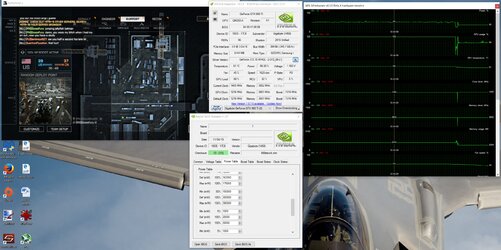Code:
OC core TDP % PSU out GPU pow
-50 1127 86 282.9 214.9
0 1177 88 288.7 220.1
50 1227 90 292.9 224.7
100 1277 91.9 298.5 230
150 1327 93.9 304.6 234.4
200 1377 95.7 307.5 239.1
250 1427 97.5 313.2 243.5
Ok, I did the testing to see how things scale giving the above table. I ran Heaven and looked at the TDP % in GPU-Z, and power supply output in Corsair Link. It soon became obvious this wasn't going to work as the scene changed in Heaven, the power changed significantly also. So I stopped it where it was, near the dragon status and I moved the camera a bit to look at the statue, and left it like that for the rest of the testing. Variations became much smaller then.
In this scene, my current 980Ti is shown as voltage limited and the core voltage didn't budge from 1199mV for the whole test. I also didn't touch the ram at all, leaving it at 3505 reported.
I varied the clock from -50 to +250 MHz in 50 MHz steps, around the nominal clock of 1177. To do some averaging of the values, I fired up hwinfo64 which samples and shows an average value also. After changing the clock, I waited a few seconds then reset hwinfo64. Then I waited at least 30 seconds before writing down the average shown in the table above.
The reported TDP % went up 2, 2, 1.9, 2, 1.8, 1.8 points. Averaging out overall just over 1.9%/50MHz. Fairly linear, but is it dropping slightly on the top end? I would speculate at this point, since I kept the memory clock static, might that start to limit as the core increased? It may be more useful if I could have measured GPU FLOPS vs power.
Similarly for the PSU power, it went up 5.8, 4.2, 5.6, 6.1, 2.9, 5.7. More variability here, as the PSU reported values moved around a lot more. Still, there seems to be a trend of about 5W/50MHz overall.
The reported GPU power seems to be derived from the TDP %, as it seems to be converted at a rate of 100% = 250W. There is a minor variation which is likely due to a combination of rounding error and possibly samples taken at slightly different times.
For fun I also fired up FurMark. Reported TDP was around 99% (with limit at 100%), and PSU power around 320W. Relaxing power limit to 110%, TDP went up to 108% (271W) and PSU was just over 345W. I noted the clocks and voltages in this state were lower than for heaven. By stressing different parts of the GPU, we can't compare directly across different loads. It is probable that the slope will vary according to the load, until such time it hits one of its limits. In other words, there is no fixed relation between core clock and TDP, as it will depend on the load. However for a constant load, the two do appear proportional if not under some other limit.
Back to my earlier question, it would seem regardless of the load I throw at it, the maximum power will be limited to 275W after OC without bios mod. With two such GPUs together taking up to 550W, that leaves 200W for use elsewhere. I wonder how likely it is to reach 275W per card outside of FurMark...
